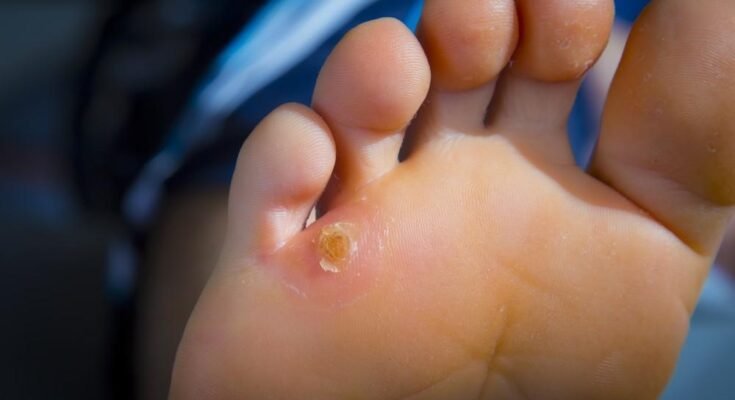Our feet take us through thousands of steps a day, but all too frequently are not cared for until pain is created. One of the most prevalent issues people deal with is corn on feet. Let’s examine both in detail to understand what they are, how they happen, and how significant they are.
Corn on Feet – Causes, Symptoms, and Treatment
What is a Corn on the Foot?
A corn is an area of thickened skin that occurs as a result of chronic friction or pressure, typically over the bony prominences of the foot. Corns are a body defensive mechanism against injury to subjacent tissues.
Causes of Corns
The main reason for corn is constant pressure or rubbing against the skin. It may be caused by:
- Shoes that do not fit – Shoes that are too tight will rub against specific areas of the feet.
- High heel shoes – They put additional pressure on the toes and the ball of the foot.
- Foot deformities – Deformities like bunions, hammertoes, or other forms lead to rubbing.
- Barefoot walking – Skin does not have cushioning and thus comes into contact with higher friction.
- Inadequate socks – Failure to wear socks or the use of scrubbing-textured socks will cause skin irritation.
Symptoms of Corns
- Small, rounded, thickened skin area that is raised
- Pain or tenderness on application of pressure
- Dry, scaly, or waxy skin over the affected area
- Hard core in center (in hard corns)
Treatment and Prevention
Home care for Corns
- Change shoes – Wear spacious shoes that are comfortable.
- Protective pads – Wear moleskin or corn cushions to prevent friction.
- Moisturizing – Softens the skin and prevents hardening.
- Warm water soaks – Softens corns so dead skin peels off more easily.
Medical Treatment
- Debridement – A podiatrist surgically shaves off thickened skin.
- Medicated pads – Salicylic acid dissolves dead skin.
- Orthotics – Custom shoe inserts to re-align foot structure.
Prevention Tips
- Wear well-fitting shoes.
- Avoid prolonged use of high-heeled shoes.
- Keep feet dry, clean, and lubricated.
- Replace old shoes and socks.
PAC in Medicine – Two Different Meanings
In the practice of medicine, PAC can mean two quite different things depending on the specialty and practice setting. The two most frequently used ones are:
- PAC – Premature Atrial Contraction (Cardiology)
Definition:
It’s an early beat of the heart rhythm which is perceived as a “skipped beat” or slight flutter.
Causes:
- Nervousness and stress
- Too much caffeine or alcohol
- Smoking
- Heart disease or hypertension
- Electrolyte imbalance
Symptoms:
- Sensation of skipped or extra beats
- Fluttery chest sensation
- In the majority of situations, none
Diagnosis:
- Electrocardiogram (ECG) – Picking up abnormal beats
Management:
- No treatment is usually required for infrequent PACs.
- In some cases where PACs are persistent or symptomatic, drug therapy such as beta-blockers can be used.
PAC – Pre-Admission Clinic (Hospital Treatment)
Definition:
A Pre-Admission Clinic is an in-patient ward in a hospital where patients for surgery or therapy are checked prior to the operation.
Purpose:
- Prepare patients for operating and anaesthesia
- Medically assess risks in advance
- Teach patients about preparation and rehabilitation
Process:
- Medical history review
- Physical check-up and laboratory investigations, if required
- Discussion with the anesthetists and the operating team
- Advising on control of drugs, fasting, and post-operative treatment
Benefits:
- Reduces surgical risks
- Makes patients more confident and ready
- Prevents last-minute cancellation because of unexpected medical conditions
Conclusion:
From foot corns to PAC in medical, the words are harmless-sounding but frightfully severe in clinical practice. Corns, as ubiquitous and harmless as they are, can be agonizingly painful if neglected but with cautionary care and preventive measures, they are manageable. PAC, as either a word used to describe a Premature Atrial Contraction or a Pre-Admission Clinic, is an essential element of heart health and surgery safety.
By learning about these conditions and services, we can take a positive step forward to healthier living from toe nail care to having our hearts (literally and figuratively) ready for life’s next steps.




